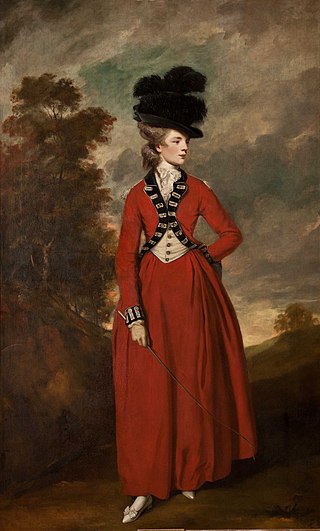Top Qs
Timeline
Chat
Perspective
Portrait of Lady Worsley
Painting by Joshua Reynolds From Wikipedia, the free encyclopedia
Remove ads
Portrait of Lady Worsley is a 1779 portrait painting by the British artist Joshua Reynolds depicting Seymour, Lady Worsley. Worsley was the wife of Sir Richard Worsley, 7th Baronet, who she had married in 1775. She is shown in a riding habit customised to resemble the uniform of the South Hampshire Militia of which her husband was colonel.[1] At the time there was a patriotic outburst following the entry of first France and Spain into the American War of Independence. The year of the painting a Franco-Spanish fleet threatened an invasion of England known as the Armada of 1779. Reynolds spotted Lady Worsley wearing her riding costume at Coxheath military camp. The painting was intended to complement a 1775 portrait of Sir Richard wearing his uniform.[2] She later became involved in a notorious scandal in 1782 when she ran off with her lover, who was sued by her husband for criminal conversation.
In the painting she holds a riding crop in her right hand, an allusion to her skill at horsemanship.[3] Reynolds was the first President of the Royal Academy and he displayed the work at the Royal Academy Exhibition of 1780 at Somerset House. The painting was last purchased by American businessman Stephen Schwarzman from the collection of Harewood House in Yorkshire for £25 million.[4][5]
Remove ads
Controversy Over Sale
Summarize
Perspective
As a result of the sale, Marcia Pointon, Professor Emerita in History of Art, University of Manchester, UK, wrote to the Financial Times Newspaper on January 31st 2025.
The letter was published and headed 'Reynolds sale should irk Britain’s art-loving public.'
Pointon wrote:
'Representatives of the art trade will doubtless note your front page report “US billionaire’s record swoop rocks London art market” (January 25). Their interest in the story is purely pecuniary and, having found a way of circumventing the internationally respected UK reviewing process for the export of works of art and objects of cultural interest, they are no doubt cracking open the champagne.
But the nation’s art-loving public, and students and scholars of the history of 18th-century Britain, are impoverished. Harewood House in West Yorkshire, which we are told needs the money, has been exemplary in making its collections available to view and engaging with questions about the production and reception of artworks.
The painting in question — Joshua Reynolds’ “Portrait of Lady Worsley” (circa 1776), reproduced in colour in your article — shows the subject wearing a riding habit in a “mode militaire” that was adopted in support of national militias at a time of growing fears about a French invasion.
Inferring political messages from a dress is in the news again with Jo Ellison’s column about Donald Trump’s wife, Melania (“Who’s afraid of Melania Trump?”, Life & Arts, January 25).
Stephen Schwarzman, a Trump supporter who was given an honorary knighthood last year by the UK government, owes it to the British nation whose cultural heritage he is acquiring to offer assurances that the works of art he is purchasing will not at some later date be transported to his overseas property and that adequate provision will be made for public viewing.
Meanwhile, the government needs to consider urgently how to ensure our cultural heritage remains not only in the UK but accessible to the public.'
Two comments to the above letter were made in the Financial Times.
Comment 1:
'Schwarzman's would need an export license to move the painting abroad. Not sure why he, and he alone, should be subject to any additional regulation in this regard. No one can be certain but I would anticipate Schwarzmann to respond favourably to the NG et al should the latter request any of these paintings for the purpose of an exhibition.
Perhaps the writer is particularly exercised because Schwarzmann is a “Trump supporter”? BTW would the author of this letter care to consider that there wasn’t exactly a brilliant choice of candidates available to vote for…'
Comment 2:
'Great points-I completely agree with this letter.
The government must act to protect masterpieces like Portrait of Lady Worsley from being exported in the future.
The media is always quick to point out that the UK has plenty of paintings by Reynolds in national collections. This is not correct.
A lot of paintings are ascribed to Reynolds but they are of inferior quality and likely painted fully or substantially by his studio assistants. The art trade has been complicit in this deception in marking paintings fully by Reynolds when they are quite obviously painted by very inferior artists ie studio assistants.
The true Reynolds masterpieces , painted fully by him, that show his genius are very very few. A lot were shipped/sold off by Lord Duveen to rich Americans (Huntington, Morgan, Frick, Mellon etc) at the beginning of the last century.
Luckily the government recently acquired the full length masterpiece of the Earl of Carlisle in lieu of tax. And, over a decade ago, the Tate bought the Archers.
But what about other full-length Reynolds' masterpieces that are at risk as they are still in private collections in the country: the absolutely magnificent Marlborough family, the Philip Gell and Lady Worsley.
These masterpieces will always be at threat of purchase by another foreign billionaire or rich foreign institution. No UK institutions has the fire power to compete for these works.
The government must act.'
Remove ads
References
Bibliography
Wikiwand - on
Seamless Wikipedia browsing. On steroids.
Remove ads

